
Visby Cathedral is a cathedral in Visby in Sweden. Belonging to Visby Cathedral Parish of the Church of Sweden, it serves the Diocese of Visby. and was inaugurated on 27 July 1225.

Bro Church is a medieval era Lutheran church at Bro on the Swedish island Gotland. Situated on what was possibly a pre-Christian sacred site, the presently visible church was built during the 13th century. Stylistically, its architecture shows a mix of Romanesque and Gothic elements. It still contains some medieval furnishings, including a baptismal font by Sigraf, and murals. The church belongs to the Väskinde parish in the Diocese of Visby of the Church of Sweden.

Bunge Church is a medieval church in Bunge on the Swedish island of Gotland. The church seen today was largely built during the 14th century and is in a High Gothic style typical for churches on Gotland. Inside, the church is richly decorated with medieval murals, including depictions of medieval knights whose significance remain contested. Bunge Church belongs to the Church of Sweden and lies in the Diocese of Visby (Sweden).
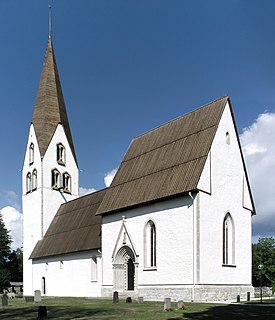
Garde Church is a medieval church in Garde on the Swedish island of Gotland. It was built in stages during the Middle Ages. The oldest part is the nave and the base of the tower, while the most recently constructed part is the large chancel. A large renovation was carried out in the 1960s. Garde Church together with its cemetery and its four lychgates constitute one of the most well-preserved medieval church ensembles in Sweden.

Fröjel Church is a medieval church in Fröjel on the Swedish island of Gotland. Fröjel Church may have been built to serve not only as a church, but also as a fortification. Stylistically, it is a mix of Romanesque and Gothic architecture, and contains murals from the early 14th century. It is associated with the Diocese of Visby of the Church of Sweden.

Gothem Church is a medieval church in Gothem on the Swedish island of Gotland. Gothic in style, it has remained largely unaltered since the 14th century. It lies in the Diocese of Visby.
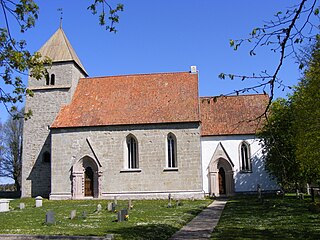
Hablingbo Church is a medieval church in Hablingbo on the Swedish island of Gotland. It is one of the largest churches on Gotland, and dating largely from the 14th century, although the current church building was preceded by a stave church. The stone portals of the church are comparatively richly decorated. It is used by the Church of Sweden and part of the Diocese of Visby.

Lau Church is a medieval church on the Swedish island of Gotland, in the Diocese of Visby. It is an unusually large church, and may have been used by Dominicans preaching for the Crusades.
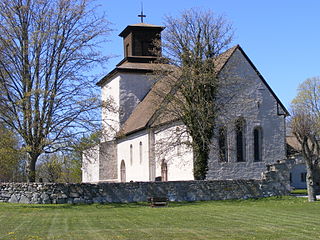
Vamlingbo Church is a medieval church on the Swedish island of Gotland, and one of the largest on the island. It lies in the Diocese of Visby.

Anga Church is a 13th century church in Anga on the Swedish island of Gotland. It is one of the most well-preserved Romanesque churches on Gotland, and was possibly preceded by a stave church. Inside, the church is decorated with medieval murals from three different periods, as well as some medieval furnishings. Some wooden sculptures from the church are today exhibited in a museum in Visby. The church belongs to the Church of Sweden and lies within the Diocese of Visby.

Öja Church is a medieval church in Öja on the Swedish island of Gotland. The church dates from the 13th century and contains an unusual large and elborately decorated triumphal cross or rood. It belongs to the Church of Sweden and lies in the Diocese of Visby.

Lye Church is a medieval church on Gotland, Sweden. The oldest parts of the church date from the last quarter of the 12th century, and the last major addition was the disproportionately large chancel, built during the second quarter of the 14th century by a workshop known by its notname as Egypticus. The workshop was also responsible for constructing the largest of the church portals, which is also decorated with Gothic stone sculpture. The tower portal contains sculptures attributed to the Romanesque sculptor Sigraf. The church has been little altered since the end of the Middle Ages. Lye Church contains the largest preserved set of medieval stained glass windows in the Nordic countries, and its interior is also decorated by medieval wall paintings, uncovered in the 1950s. The altarpiece is from 1496, and the church also contains a triumphal cross from the same period.
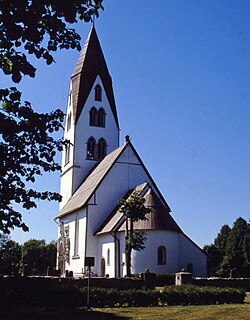
Stånga Church is a medieval church in Stånga on the Swedish island of Gotland. The site of the church has probably been considered sacred since before the Christianization of Scandinavia.

Hemse Church is a medieval Lutheran church in Hemse on the island of Gotland. Preceded by the most well-preserved early stave church discovered in Sweden, the current church dates mainly from the 13th century. It contains sets of medieval murals as well as some medieval furnishings. It is part of the Diocese of Visby.

Lärbro Church is a medieval church in Lärbro on the Swedish island of Gotland. The church is located at a former strategically important spot, as testified by the adjacent fortified tower. The presently visible Gothic church replaced an earlier Romanesque church during the 13th and 14th century. The cemetery of the church contains several graves of victims from Nazi concentration camps who were taken to a field hospital in Lärbro during and after World War II.

Buttle Church is a medieval church in Buttle on the Swedish island of Gotland. It is one of the more well-preserved Romanesque churches on Gotland, and contains both a number of medieval furnishings as well medieval murals. Buttle Church belongs to the Diocese of Visby of the Church of Sweden.

Endre Church is a medieval church in Endre on the Swedish island of Gotland, in the Diocese of Visby, built from the 12th to early 14th century. It contains medieval murals and several medieval furnishings, and belongs to the Church of Sweden.
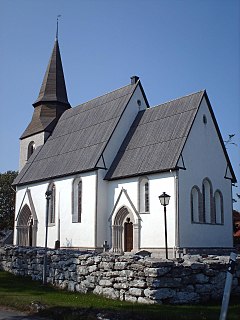
Fole Church is a medieval church in Fole on the Swedish island of Gotland. The Romanesque tower is the oldest part of the otherwise largely Gothic church. It belongs to the Church of Sweden and lies in the Diocese of Visby.

Rone Church is a medieval church in Rone on the Swedish island of Gotland. The Gothic church contains a number of medieval murals. It is part of the Church of Sweden and lies in the Diocese of Visby.





















